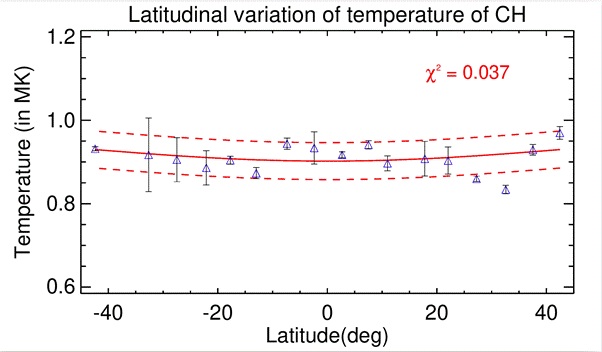Ministry of Science & Technology
Thermal structure of solar coronal holes and their magnetic fields unveiled
प्रविष्टि तिथि:
18 FEB 2025 4:27PM by PIB Delhi
A new study has accurately estimated the physical parameters of thermal and magnetic field structures of solar coronal holes which have significant influence on space weather that affects satellites, as well as the Indian summer monsoon rainfall.
Coronal holes, which are dark regions in X-ray and extreme ultraviolet images of the Sun, have open magnetic field lines and are hence important for understanding the interplanetary medium and space weather. The latitude dependence of temperature and the magnetic field strengths of these coronal holes have now been characterised accurately by astronomers from the Indian Institute of Astrophysics.
Discovered in the 1970s by X-ray satellites, "coronal holes" in the sun's atmosphere are dark in the X-ray and EUV wavelengths, and are low-density regions that have open magnetic field structures in the interplanetary space. These solar activity phenomena are intense sources of fast (450-800 km/sec) solar wind—streams of charged particles that escape from the sun, more easily into space.
At present, this high-speed solar wind can interact with the Earth's magnetic field, causing disturbances like geomagnetic storms. Effects of sunspots on the Earth's atmosphere and climate are well recorded.
Interestingly, a recent physics-based study came to the conclusion that, in addition to influence of sunspots, parameterized study of radiative effects of coronal holes explains satisfactorily the variability of Indian Monsoon rainfall. Moreover, occurrences of coronal holes are associated with disturbances in the Earth's ionosphere, the layer of the atmosphere that reflects and modifies the radio waves, leading to further communication issues.
Considering these imminent dangers of space weather effects and long-term influence of the solar coronal holes on the Indian Monsoon rainfall it is important to study their thermal, magnetic field structures and their origin. Thermal means, estimation of temperature, radiative flux and energy of the coronal holes that emanate on the sun and at Lagrangian point at space, near the Earth. If one knows the temperature structure of coronal holes, from their latitudinal variation on the sun, one can estimate their depths of origin during their initial evolutionary stage in the deep solar interior.
On the other hand, estimation of radiative flux and energy of the coronal holes will be useful for estimation of input of this thermal energy into the interplanetary space. Moreover, information of latitudinal variation of temperature structure of coronal holes indirectly leads to estimation of magnetic field structure of coronal holes that ultimately give the clue for understanding the formation of coronal holes.
Keeping these important facts in mind, astronomers of Indian Institute of Astrophysics (IIA), an autonomous institute of Department of Science and Technology, used eight years of full-disk calibrated images observed by the Solar and Heliospheric Observatory (SOHO) space probe to study these coronal holes. These were unambiguously detected and physical parameters of thermal and magnetic field structures of coronal holes were accurately estimated.
“The study published in published in the journal Astronomy and Astrophysics also offers a comprehensive understanding of how these near-equatorial coronal holes evolve as they traverse the solar disk. In addition to estimation of different physical parameters of coronal holes, two important findings emerged from this study,” said Dr Manjunath Hegde of IIA, and lead author of the study.
“We found that there is no latitudinal variation of temperature structure of coronal holes and also that there is a latitudinal variation of strength of magnetic field structure of coronal holes that increases from the solar equator to the pole. The first result suggests that coronal holes are likely to originate from the deep interior, whereas the second result suggests that coronal holes might have formed from the superposition of Alfven wave perturbations”, said Dr K.M. Hiremath from the same institute.


Figure 1a & 1b
(a): full-disk SOHO/EIT 195 Å image of 04-01-2001, 00:00:11 UT with detected CHs. (b): contour map of the southern CH with a given threshold.

Figure 2
Corona hole temperature variation (shown as blue triangles) across latitudes. The continuous red line represents a least-squares fit and dashed red lines depict one standard deviation error bands computed from all data points. While χ2 serves as a measure of the goodness of fit.
***
NKR/PSM
(रिलीज़ आईडी: 2104369)
आगंतुक पटल : 1436